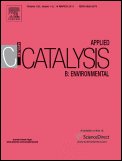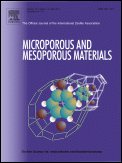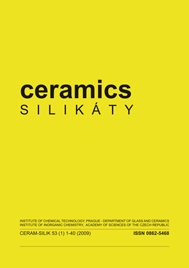
2006

Štengl, V.; Bakardjieva, S.; Šubrt, J.; Večerníková, E.; Szatmary, L.; Klementová, M.; Balek, V., Sodium titanate nanorods: Preparation, microstructure characterization and photocatalytic activity. Applied Catalysis B-Environmental 2006, 63 (1-2), 20-30.
Abstract: A method for the preparation of sodium titanate nanorods with diameter around 50 nm and lengths up to 2–3 μm is described. The precursor prepared by the reaction of sodium titanate with ethylene glycol readily aggregated into 1D nanostructures. During heating of this precursor up to 900 °C the glycolate complex of sodium titanate decomposed and a crystalline product of the chemical composition Na2Ti6O13 with the morphology of nanorods was formed. The initial sodium titanate sample as well as samples heat treated to 550–900 °C, respectively, were characterized by X-ray diffraction, infrared spectroscopy, electron microscopy (SEM, TEM, HRTEM) thermal analysis methods (DTA–TG-coupled with mass spectroscopy and emanation thermal analysis) as well as by surface area and porosity measurements. It was demonstrated that the nanorods formed by heating of the precursor at 900 °C/2 h exhibit a good photacatalytic activity for the decomposition of 4-chlorophenol in an aqueous slurry under UV radiation. Link

Abstract: Mesoporous titania aerogel with high surfaces area (1086 m2 g−1) were prepared by two steps: heterogeneous precipitation of aqueous solution containing TiOSO4 and ammonia, followed by continuous supercritical extraction with CO2 after replacement of the water with n-propanol/benzene mixture. The total pore volume of as obtained aerogel is 3.44 cm−3 g−1 and the main pore diameter is 20–80 nm. The structure evolution of titania aerogel during heating was studied by DTA and high temperature XRD analyses. At 450 °C titania aerogel transforms to polycrystalline anatase. The morphology and microstructure characteristics of both titania aerogel and anatase samples were obtained by SEM, HRTEM, BET and BJH methods. Anatase reveals high photocatalytic activity during the degradation of 4-chlorophenol in aqueous suspension. Link Lukáč, J.; Bakardjieva, S.; Štengl, V.; Szatmary, L.; Šubrt, J., Hydrous aluminium-oxides prepared by homogeneous precipitation from aluminium(III)sulphate with urea. Ceramics-Silikaty 2006, 50 (1), 22-26.
Štengl, V.; Bakardjieva, S.; Šubrt, J.; Szatmary, L., Titania aerogel prepared by low temperature supercritical drying. Microporous and Mesoporous Materials 2006, 91 (1-3), 1-6.
 Bakardjieva, S.; Štengl, V.; Szatmary, L.; Šubrt, J.; Lukáč, J.; Murafa, N.; Nižnanský, D.; Čižek, K.; Jirkovský, J.; Petrova, N., Transformation of brookite-type TiO2 nanocrystals to rutile: correlation between microstructure and photoactivity. Journal of Materials Chemistry 2006, 16 (18), 1709-1716.
Bakardjieva, S.; Štengl, V.; Szatmary, L.; Šubrt, J.; Lukáč, J.; Murafa, N.; Nižnanský, D.; Čižek, K.; Jirkovský, J.; Petrova, N., Transformation of brookite-type TiO2 nanocrystals to rutile: correlation between microstructure and photoactivity. Journal of Materials Chemistry 2006, 16 (18), 1709-1716.
Abstract: Nanometric particles of pure brookite TiO2 were synthesized by modified thermolysis of reactant solutions containing titania powder, HCl, urea and PEG 10000. Unique flower-like brookite agglomerates with an average diameter of 400–450 nm composed of single brookite nanocrystals of 4–5 nm were obtained at 105 °C. The brookite → rutile transformation has been studied and TiO2 mixtures with variable amount of anatase, brookite and rutile polymorphs at different temperatures (from 200 to 800 °C) were obtained. High resolution transmission electron microscopy (HRTEM), electron diffraction pattern and BET/BJH analyses were used to characterize the phase assemblages, crystallite size and pore volume of the pure-phase brookite and TiO2 mixtures. In order to understand the metastable–stable TiO2 phase transformation X-ray powder diffraction (XRD) was performed. The photoactivity of pure brookite and TiO2 powders with different compositions of the brookite–anatase–rutile and anatase–rutile polymorphs obtained during the transitions was examined by photocatalyzed degradation of 4-chlorophenols in aqueous solution. The titania sample having the highest catalytic activity was obtained at 500 °C, contained 3.2% brookite, 42.9% anatase and 53.9% rutile and is referred to as TiO[B])/500. Link
 Šubrt, J.; Štengl, V.; Bakardjieva, S.; Szatmary, L., Synthesis of spherical metal oxide particles using homogeneous precipitation of aqueous solutions of metal sulfates with urea. Powder Technology 2006, 169 (1), 33-40.
Šubrt, J.; Štengl, V.; Bakardjieva, S.; Szatmary, L., Synthesis of spherical metal oxide particles using homogeneous precipitation of aqueous solutions of metal sulfates with urea. Powder Technology 2006, 169 (1), 33-40.
Abstract: Spherical micron sized porous particles of goethite FeO(OH), boehmite AlO(OH), anatase TiO2, Zn(OH)2 and binary mixtures of these oxides have been synthesized by homogeneous precipitation from aqueous solution containing urea in the presence of corresponding metal sulfates. Metal (hydrous) oxide particles obtained show spherical morphology and consist of agglomerated randomly oriented nanocrystallites. Synthesized metal oxide hydroxides were characterized using Brunauer–Emmett–Teller (BET) surface area and Barrett–Joiner–Halenda porosity (BJH), X-ray diffraction (XRD), transmission electron microscopy (TEM), scanning electron microscopy (SEM) and energy-dispersive X-ray microanalysis (EDX). Link
Abstract: Easily filtrated alumina-oxides spherical precursors were prepared by homogenous precipitation from aluminium(III) sulphate with urea. Urea was employed as precipitation agent. X- Ray powder diffraction (XRD) spectra identified three different phases, namely: a-boehmite, boehmite and hydrobasaluminite. The morphology of prepared samples was observing by SEM (scanning electron microscopy) equipped with EDX (energy dispersive analysis by X-rays). The spherical clusters were examined at small concentration and the hydrobasaluminite islands were observed at the largest concentration of reagents. The microstructure characteristics were obtained by BET (Brunauer-Emmett-Teller) and BJH (Barret-Joyner-Halanda) methods. BET in wide range from 6 to 142 m2/g and the all kinds of porous distribution were acquired, respectively. These methods showed that relationship between phase structures and microstructure exists. www.ceramics-silikaty.cz/2006/2006_01_022.htm
Kontakt
Ústav anorganické chemie AV ČR v.v.i.
250 68 Husinec-Řež
266 172 202
stengl@iic.cas.cz; stengl@me.com